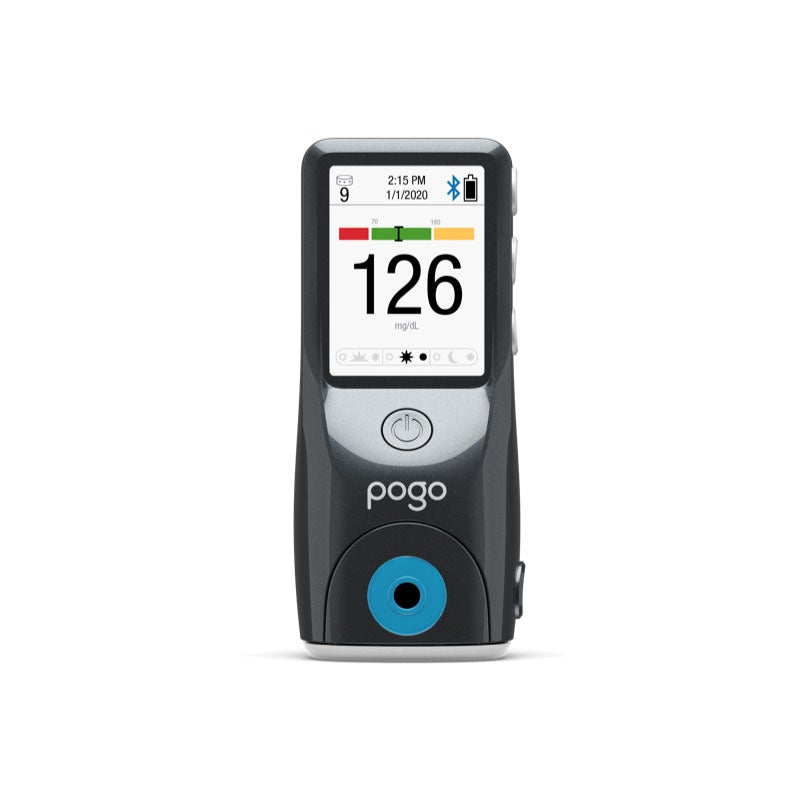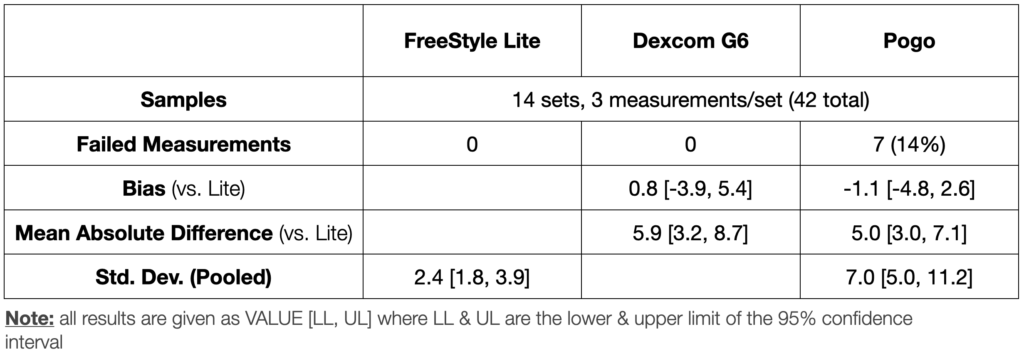
A few weeks ago I saw an article about an interesting new blood glucose meter, the Pogo Automatic Blood Glucose Meter. According to Pogo’s website, the device:
- Contains the meter, lancets, and strips in a single, compact device
- Automates changing of lancets and test strips
- Automates pricking your finger, drawing of blood, and transferring the blood to the test strip
- Uses less blood than traditional meters (0.25 μL)
- Meets FDA accuracy requirements (±15% vs. reference meter)
Carrying around a bag with my meter, lancing device, extra lancets, and strips is mildly annoying, so the Pogo sounded like it could be a nice upgrade. To see whether the Pogo was a good as claimed, I bought one and tested it vs. my current meter (FreeStyle Lite) and CGM (Dexcom G6).
Summary
- I tested 14 sets of 3 measurements each with the Pogo and FreeStyle Lite (98 total)
- Good
- The Pogo is very easy to use and could be a big improvement for someone with poor manual dexterity
- Bad
- Less reliable: 7 out of 49 failed measurements (14%) vs. 0 for the FreeStyle Lite
- Less precise: standard deviation of 7 vs. 2.5 mg/dL for the FreeStyle Lite
- Hurts more: both during lancing & caused sore fingers afterwards
- Prolonged bleeding: often bled for >1 min. after lancing
- Slow: >10s to take a measurement vs. <5s for the FreeStyle Lite
Overall, while having everything in a single device is convenient, it’s not even close to worth the poor reliability, reduced precision, and increased pain & bleeding.
Conclusion: I’ll be sticking with my FreeStyle Lite.
This is the first “product review” I’ve done and I’m curious if it’s interesting/useful for people. If you have diabetes or other quantified self products you’d like me to test, please let me know in the comments.
Details
Experiment
- Over the course of 9 days, I did 14 sets blood glucose measurements and random times.
- Each time, I took 3 measurements each with the Pogo and FreeStyle Lite, and recorded the result from my Dexcom G6.
- I also recorded any failed test strips or other observations.
- For each meter, I calculated the difference pooled standard deviation, bias (vs. Lite), and mean absolute difference (vs. Lite).
Raw data & analysis: link
General Observations
Good
- It took me a couple tries to get the hang of the technique, but the Pogo is very easy to use. You just turn it on, press your finger on the lancing area, and the Pogo handles the rest.
- The 10 strip/lancet cartridge is easily inserted into the device, no finesse required.
- If you have poor manual dexterity, the fact that everything is automated might be a big advantage.
Bad
- The Pogo is much slower than a normal meter. It takes a few seconds to turn on and waits a few seconds each before lancing and collecting blood. Overall, it takes >10 seconds to get a reading on the Pogo vs. <5 seconds on my FreeStyle Lite. Not terrible, but very noticeable.
- Lancing hurts a lot more than my normal meter. This seems to be due to a combination of the fact that I can’t control the lance depth and that I’m not in control of when the lancing occurs, which is psychologically more difficult for me.
- My fingers were often sore where I used the Pogo. I never had any soreness where I used the Freestyle Lite
- The Pogo was less reliable in drawing blood. In 6 out of 42 tests (14%), the Pogo asked me to “milk” my finger for more blood.
- Wounds from the Pogo often bled for much longer than my normal lancing device (sometimes >1 min). I had to be careful not to touch anything for a few minutes after testing to avoid getting blood on things.
Precision

Summary statistics are showing in the table above. The Pogo was:
- Well calibrated: small and not statistically significant bias vs. the FreeStyle Lite
- Less reliable: 14% failed tests vs. 0 for the Freestyle Lite
- Less precise: standard deviation of 7.0 [5.0, 11.2] vs. 2.4 [1.8, 3.9] for the FreeStyle Lite
Importantly, the Pogo showed about the same mean absolute difference as the Dexcom G6, indicating that it wouldn’t add much value as a secondary check of my CGM, which is the main reason I carry a fingerstick meter.
Conclusions
See summary above.
– QD